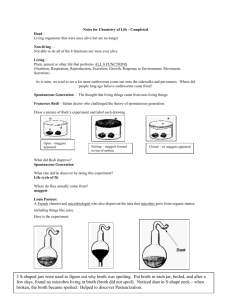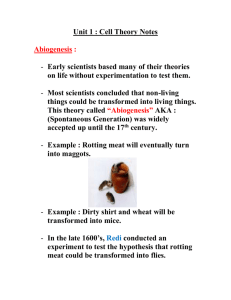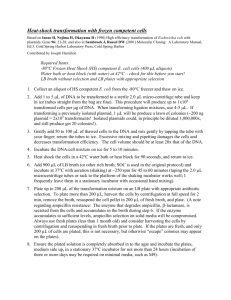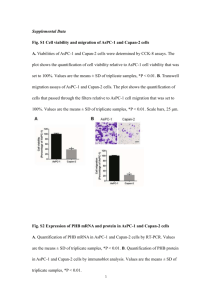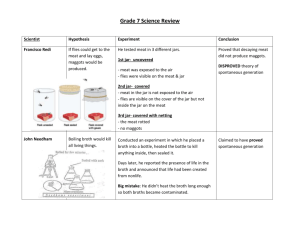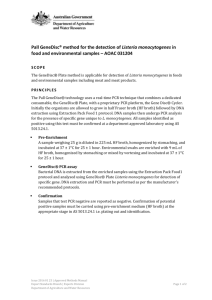Ralstonia eutropha Zooglea ramigera Spberoplast Formation in and
advertisement
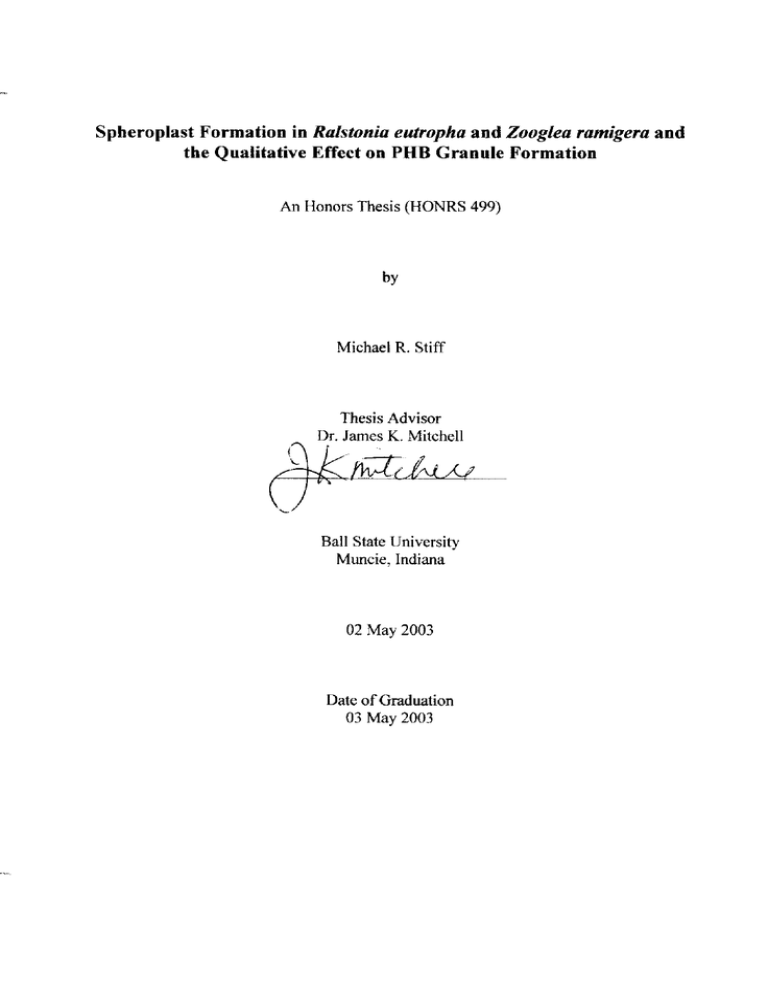
Spberoplast Formation in Ralstonia eutropha and Zooglea ramigera and tbe Qualitative Effect on PHB Granule Formation An Honors Thesis (HONRS 499) by Michael R. Stiff Ball State University Muncie, Indiana 02 May 2003 Date of Graduation 03 May 2003 Abstract The United States is a leading producer ofthe world's municipal solid waste much of which is non-biodegradable plastic. The waste plastic contributes to the rising cost of waste management and has a negative impact on the environment. The use of biodegradable plastics such as polyhydroxybutyrate (PHB) could reduce waste management costs and environmental damage. Unfortunately the cost ofPHB production is higher than the cost of petroplastic production, so there are few providers of this alternative. The cost ofPHB production could be reduced by growing PHB producing microorganisms such as Ralslonia eulropha and Zooglea ramigera as spheroplasts. Spheroplasts of these organisms were induced in an isotonic broth by treating shake-flask cultures with penicillin g or lysozyme. Growth of each organism in this broth was compared to growth in broth without 2%NaCI, and PHB granules were observed in each organism taken from either broth. 2 Acknowledgements There are a number of people that I wish to acknowledge for their support and assistance: my peers Rurik Wuensch and Lissa Anderson for putting up with all the noise from the shaker, Dr. Carolyn Vann for her ready answers of my silly questions, and Dr. Carl Warnes for the use of various Jab equipment and advice. Most significant to the fruition of this research project was the guidance of my project advisor Dr. James Mitchell who essentially gave me his lab for the duration of this project in addition to his expertise, wisdom, and encouragement. [ would be remiss if I did not also acknowledge my sister Kurstin and her newborn daughter Jamie Michelle. The birth of my tiny niece during the course of this project underlines for me the significance of discovering novel approaches to preserving and protecting our environment. 3 Spheroplast Formation in Ralstonia eutropha and Zooglea ramigera and the Qualitative Effect on PHB Granule Formation Michael R. Stiff College ofScience and Humanities, Department of Biology, Ball State University, Muncie, IN 47306-0725 Submitted 2 May 2003 Abstract appears on the previous page to conform to Ball State Honors College Undergraduate Thesis guidelines. Almost half of the world's municipal solid waste is produced by the United States, 400 billion pounds each year. Only a third of this is recycled or composted leaving the rest to be incinerated or, as with over half of all U.S. municipal solid waste, landfilled. Plastics account for 30% of this landfilled waste, approximately 60 billion tons according to E.S. Stevens (17). Most plastics waste is single-use packaging material discarded after less than a year or much sooner in many cases and to a lesser amount heavy-duty construction materiaL Neither of these will biodegrade. The environmental burden presented includes increasing landfill size, indefinite storage of chemical energy unusable to the environment and its constituent life, and in some cases such as polychlorobiphenyls, PCBs, toxicity. Stevens points out that in addition to the environmental burden that plastics waste and non-biodegradable waste in general produce, the economic burden of managing the waste is a concern. A step toward alleviating both burdens is found in biodegradable plastics. There are many examples of these bioplastics, but one promising polymer in particular is polyhydroxybutyrate, PHB. 4 PHB is made of a repeating unit of butyric acid (Fig. I). It can be shaped and has physical properties similar to the non-biodegradable petroplastic polypropylene (2), the plastic used for packaging film, bottles, food-container lids, and many other products. !. L CH, I PHB is produced in the cells of a variety of microorganisms O-l II and is observed in discrete granules. The microorganisms 0 ·· CH· . CH, - i::.-.: n Figure I. The single repeating unit of PHB. The subscript n represents the number of units in a given chain of PHB. use PHB as an energy storage material like animals use fat. Lemoigne first discovered the microbial production of PHB in Bacillus megaterium in 1926 (3), but it was not until the late 1950s and early 1960s that PHB began to be evaluated for commercial use. Despite this interest, it was not until the late I 970s and early 1980s that commercial interest began to develop into large-scale production at ICI in Great Britain (3). Their biodegradable plastic was called Biopol® and has since been purchased by Monsanto Company, then subsequently purchased by Metabolix, Inc., which is working on optimizing production through the transfer of PHB producing genes from microorganisms into plants to lower the cost of production/make the cost worth the financial benefit (15). The benefit of PHB production in plants is the potential to lower raw materials cost because all a plant needs to produce PHB are the genes, land, water, CO 2, and sunlight. In contrast, microbial PHB production requires investment in large ferrnentors and all of the raw materials for microbial growth. The hope for PHB production in plants oversimplifies the reality of farming, for example, by not accounting for fertilizer, variability in weather, and the cost of harvesting. Work to make PHB production less expensive is increasingly more important because despite the environmental and waste management economics benefits described before, the cost of production is inhibiting because petroplastic is much less expensive to produce. 5 Presently, researchers continue to seek optimization of microbial production ofPHB at every step in the process (Fig. 2). commercial production of PHB takes six steps. The first is the growth of 2. PHB Production the microorganism in all of the raw 3. Cell Collection, Drying] materials it needs to grow well. The second -------, , l4. Separatioo ofPHB from Cells (OptiooaO step is growth of the microorganism with only the raw materials that will make it r J .1. 5. Upid a'ld Pl!Jnent Extraction (Optional) 6 PHS Extraction from Cell Debris produce PHB. This has to be done because the microorganism only stores energy as PHB when there is an excess of carbon Figure 2. Diagram of commercial production of PHB from microorganisms. "Optional" steps are only such depending on the desired purity of the PHB product. Compiled from ICI patents (1, 8). source, glucose or fructose for example, and less of another nutrient such as phosphorous, nitrogen, or oxygen. Many researchers are testing different raw materials, often wastes from industrial food processing, to find inexpensive alternatives the materials used in this step (12,14,20,21). Other work is being done on the cell collection step (6) and the separation of PHB granules from microbial cells (7). Figure 2 describes this and the following step, Lipid and Pigment Extraction, as "optional." For most uses, the purity of PHB required makes these steps desirable and necessary. This investigation focuses on the separation step. Separation of PHB granules from microbial cells is desirable for most applications ofthe bioplastic because it will yield a more pure product. Current methods of separation include disrupting the cells by spray drying (9, 16), heat and pressure (II) or sonication (I) followed by centrifugation, and treatment by proteolytic enzymes (10). At the end of the process, a solvent is used to extract PHB from the leftover cell debris. 6 Treatment with proteolytic enzymes requires the least amount of extraction solvent of these methods. This is because less cell debris mixes with the PHB due to proteolytic solubilization of the non-PHB cellular material, NPCM. If less PHB extraction solvent is necessary, then the cost of solvent extraction goes down, thus driving overall production cost down. There are many bacterial species that produce PHB, however, the most widely researched is Ralstonia eutropha because of its high PHB yields. Zooglea ramigera, another bacterium, holds promise because of the ability of its cells to stick together, flocculate, which is desirable for improved separation of PHB from NPCM (18, 19). This investigation aims to determine whether the proteolytic treatment is necessary by discovering through qualitative observation whether or not two PHB producing bacteria, R. eutropha and Z. ramigera, can be cultivated as forms with no or diminished cell wall called spheroplasts, thereby having less NPCM to remove. The qualitative effect of spheroplast growth on intracellular PHB granules will also be investigated. Materials and Methods Organism, Ralstonia eutropha NRRL B-4383 and Zooglea ramigera NRRL B3303 were grown on TSA medium slants and subcultured every two weeks on fresh TSA slants for use throughout this investigation. Each organism was sensitive to penicillin g after 24 h growth on TSA plates at 3rc. Media. R. eutropha and Z. ramigera were each grown in nutritious seed broth described by Jung and Lee (12). PHB biosynthesis was induced in a fermentation broth 7 described by Cho et al (6) with the substitution of fructose for glucose as the carbon source. Spheroplasts were induced in a broth similar to the above fermentation broth but altered to contain 2%NaCI henceforth referred to as 2%NaCI broth. Cultivation in Fermentation Broth. One loopful of each organism was added to its own 20 ml of seed broth in a 125 ml Erlenmeyer flask and grown for 36 h on a shaker at 30°C, 240 rpm for cell growth. Next, 1.0 ml of organism from the seed broth was added to a 125 ml Ryan flask containing 25 ml fermentation broth for PHB production and grown for 98 h under the same conditions as the seed broth. Cell growth over time was monitored by turbidimetric measurements with a Klett-Summerson Photoelectric Colorimeter containing a blue filter. The fermentation broth was adjusted to pH = 6.8 by adding 50% NaOH. Spheroplast Induction. Each organism was grown in seed broth as described above. 1.0 ml of organism was added to 25 ml of2% NaCI broth in each of three 125 ml Ryan flasks reserved for untreated, penicillin g treated, and lysozyme treated cells. The organisms were grown in a shaker at 30°C, 240 rpm for 48 h. Cell growth over time was monitored by turbidimetric measurements with a Klett-Summerson Photoelectric Colorimeter. 50 units/ml penicillin g as described by Lark (13) or 0.5 mg/mllysozyme as described by Cheng et al (5) was added at the beginning of exponential phase, after 20 h of growth. The fermentation was repeated for R. eutropha only with the alteration of being treated with 300 units/ml penicillin g. Qualitative PHB Assay. PHB production and observations ofPHB granules were conducted by staining with Sudan Black B and observing cells at 100x magnification with a light microscope. A loopful of broth was taken from each flask at the time 8 turbidimetric measurements were taken. Granules were observed in fermentation broth and in 2% NaCI broth for untreated, penicillin treated, and lysozyme treated cells. Spheroplast Observations. Observations for spheroplasts were conducted using a phase-contrast microscope at 100x magnification. Observations of globular forms or spheres in penicillin g and/or lysozyme treated cell solutions was indicative of spheroplast formation (13). Results Growth. The growth of each organism in the fermentation broth is described in Figure 3. R. eutropha has a lag phase of 12-15 h followed by a phase of exponential growth from Growth of R. eutropha and Z. ramigera in Nonnal Fermentation Broth this time until about 28 h 600 resulting in a turbidity of .... 1 ----......F-----'''------.-----. 500 500 Klett units. Stationary -'-_~- __ Jl_~L-.­ phase begins around 28 h ~ ~~ ./ j-.--o.~ . .... ""--r-----------,j and continues past 90 h. In /" & -• - - / contrast, Z. ramigera showed a very short lag phase in the fermentation broth and a long exponential o 10 m _ ~ R. eutropha turbidity v. time R. eutropha turbidity v. time Z. ramigera turbidity v. time Z. ramigera turbidity v. tirne m m ro M • 100 Time (hrs) Irllure J. Turbidity v. Time for H. eUlropha and Z. ram/gem in Nonn:d Fl;:nnentatiol1 Broth. Turbidity is the measurement ufgrowth for the organisms in Klett unils.R. f'ulropha grew much fa~ter in Ihis medium IhM Z. ramix"ra phase from near the beginning of the fermentation to about 70 h resulting in turbidity over 300 Klett units. Stationary phase lasted until past 90 h. 9 The growth of R. eutropha and Z. ramigera in the 2%NaCI broth are described in Figure 4 and Figure 5 respectively. There is a visibly significant drop in turbidity during Growth v. Time for Untreated, Penicillin Treated, and Lysozyme Treated R. eutropha the lag phase for R. eutropha, 0-15 h. The exponential phase lasts • • :-, \---_.\ '.. -~--"OC!,......_j .. y ~-- -- - -"----- - ~ ./ - / .. ~--~ fermentation broth, 15 h to about 44 • Untreated • Penicillin Treated Penicillin Treale<l • - longer in this broth than in the -- - - - - - - h and only reaches around 80 Klett Lysozyme Treated Lysozyme Treated units whether treated with either ~~~~~~--~--~"~-=-~~~~- '" Time (h) Figurt 4. Turbidity v. Time for untreated, penicillin g treated, and lysozyme treated R. eutropha in 2%NaCI penicillin g or lysozyme or untreated. R. eutropha treated with broth. Turbidity is the measurement of gro'Wth in Klett units. lysozyme or penicillin g resulted in Growth v. Time for Untreated, Penicillin Treated, and Lysozyme Treated Z ramigera ' "- - .. ;:::: i:::::: L '00,---------------,-__==========" -~~~~ ~~:::: .,~--"-- . ~ .. Lysozyme TreMed -I r L'j'SOZ'ftnII Treated --------------- .-• . a lower peak of turbidity, between 75 Klett units to about 80 Klett units. Z. ramigera has a noticeable lag phase when grown in the • 2%NaCI broth, 0-18 h, which "Trmelh) Figure 5. Turbidity v. Time for untreated, penicillin g treated, and lysozyme treated R. eutropha in 2%NaCI broth. Turbidity is the measurement of growth in Klett units. includes a visibly significant drop in turbidity before entering a slow exponential phase that lasts until about 40 h resulting in a turbidity of around 50 Klett units. Penicillin g treatment of Z. ramigera did not appear to affect the peak turbidity, although lysozyme treatment resulted in lower peak turbidity. 10 Spheroplast Formation. R. eutropha viewed at 100x objective with a phasecontrast microscope appear as dark motile plump rods occurring singly or in loose, unconnected groups. No change is observed at this magnification immediately after treatment with 50 units/ml penicillin g. At 28 h, 8 h after penicillin g treatment, large motile globular forms were observed. When the procedure was repeated, no globular forms were observed. When the procedure was repeated with 300 units/ml penicillin g added in place of 50 units/ml, globular cells and spheres were observed, however, contamination was also observed including Z. ramigera growth in the R. eutropha samples. After treatment with 50 mg/mllysozyme, club shaped cells were observed. Following 4 h after lysozyme treatment large spheres and globular forms were also observed. Z. ramigera viewed under 100x objective with a phase-contrast microscope appears as dark motile plump rods often growing in branched colonies, zooglea, but also seen singly. No globular forms or spheres were observed after treatment with 50 units/ml penicillin g. This was the result of the experiment when it was repeated once. Z. ramigera treated with 50 mg/ml exhibited globular forms and spheres about 9 h after treatment. This was not observed when the experiment was repeated. PHB Granules. R. eutropha cells from the fermentation broth were stained for PHB granules with Sudan Black B and observed by light microscopy under JOOx objective (Figure 6). Granules were black and round against safranin counterstained nonPHB containing cells which appeared light red. Granule diameter was 0.5-1.0 !lm with most appearing to be 0.5 !lm. Z. ramigera cells from the fermentation broth were likewise stained with similar observations. 11 1-----1 12 )lffi . .' :. .'" Figure 7. Sudan Black B stained R. eutropha from 2%NaCI broth. Dark black objects are PHB granules. Gray objects arc safran in countcrstained non·PHB cells. These appear light red in color Figure 6. Sudan Black B stained R. eutropha from fermentation broth. Dark black objects arc PHS granules. Gray objects arc saf'ranin counterstained non·PHB cells. These appear light red in color R. eutropha cells from the 2%NaCI broth were stained for PHB granules with Sudan Black B and observed by light microscopy under 100x objective (Figure 7). Granules appeared similar to those in the fermentation broth except for diameter which ranged from 0.5- over 1.1 Ilm with most appearing to be around 1.0 Ilm. The large, irregular black object near the top center of Figure 7 is the sum of two granules with diameter of approximately 1.5 Ilm. Z. ramigera cells from the 2%NaCI broth were likewise stained with similar observations. Neither treatment with penicillin g or lysozyme appeared to affect PHB granule diameter or shape. Discussion Growth_ The difference observed between R. eutropha and Z. ramigera in their growth in the fermentation broth was not surprising considering the broth has been described specifically for the growth of R. eutropha only. The results indicate that a more efficient broth, one that instigates faster biomass growth and large PHB yields should be 12 defined for Z ramigera. Since this organism flocculates, a property that has been shown to be desirable for current methods of microbial PHB separation from NPCM, researching this will be beneficial to the commercial production of PHB. R. eutroDha Z. ramiiiera Fennentation Broth (Klett units) 2%NaCI Broth (Klett units) 500 300 80 50 Fold Decrease 6.25 6 Figure 8. Maximum turbidity yield from fermentation broth and 2%NaCI broth and the fold decrease observed between the two broths for each organism • The lag phase time of R. eutropha in both the fermentation broth and the 2%NaCI broth were similar, each about 15 h, so it is likely that little time if any would be lost if a salt medium were employed to provide an isotonic solution for the growth of spheroplasts. An important difference between the lag phases, however, is the large drop in turbidity in the 2%NaCI broth which resulted in a more than six fold decrease in the final turbidity, the maximum amount of organism produced (Fig. 8). The turbidity decrease during this lag phase is attributed to osmotic shock. One possibility for circumventing this large decrease is to use a seed broth that would be isotonic for spheroplast growth. This would most likely not affect the slower exponential phase seen in the 2%N aCI broth, but it would select for the hardier organisms that will survive the osmotic conditions in the PHB fermentation. The long lag phase exhibited by Z ramigera in the 2%NaCI broth not seen in its growth in the fermentation broth is attributed to osmotic shock as well which resulted in a six fold decrease in final turbidity. The use of a seed broth isotonic for spheroplasts would most likely decrease the lag phase time and the decrease in turbidity for this organism as well. 13 Spheroplast Formation. Globular forms and spheres observed for both R. eutropha and Z. ramigera were like those described by Lark (13) as induced spheroplasts. The club shapes observed for R. eutropha after treatment with 50 mg/mllysozyme suggests that lysozyme was effective in digesting part of the cell wall, but the concentration was not high enough to degrade the cell wall enough to produce spheroplasts in the isotonic broth. This fact and the lack of reproducibility of the results suggest that the conditions used in this investigation were not the optimum conditions for spheroplast formation for either organism. Varying N aCI concentration as well as the concentration of penicillin g and lysozyme should be tested in future work. Optimizing the penicillin g concentration could begin with a minimum inhibitory concentration (MIC) test. Contamination was a problem for some of the experiments in this investigation. After eliminating a number of other factors, the source of contamination was found to be most likely the level II hood. A level III hood which provides more protection against contamination should be employed for future investigations. PHB Granules. Treatment of R. eutropha and Z. ramigera with either penicillin g or lysozyme did not appear to affect PHB granules. However, granules observed from organisms growing in the 2%NaCI broth tended to be larger than those observed from organisms growing in the fermentation broth. Growth in the 2%NaCI broth stressed each organism enough to extend the time of every growth phase observed which may explain the increased PHB granule size; the organisms grew longer in the 2%NaCI broth than in the fermentation broth providing more time for PHB production. However, as of yet there 14 are apparently no studies of the effect ofNaCI concentration on PHB fonnation providing another possible avenue of future research. Summary Conclusion. R. eutropha and Z. ramigera growth in the 2%NaCI broth is slower and results in a lower final turbidity, lower biomass, than growth in the fennentation broth, but spheroplasts were observed for R. eutropha after treatment with penicillin g and for both R. eutropha and Z. ramigera after treatment with lysozyme which can prove important to the commercial production of PHB because it suggests a method for decreasing the overall cost of production. By showing that spheroplasts of these PHB producing microorganisms can be produced, it suggests that these organisms could be genetically engineered to grow without or with a significantly reduced cell wall, a large portion of the NPCM, thus reducing the amount of materials and energy needed to separate PHB from residual NPCM during large-scale production. The lower material cost, for solvents for example, and lower energy cost, for heating for example, could lower the total production cost. References I. Alderson, B., P. A. Holmes, P. J. Senior, L. F. Wright. 1980-09-03. A process for the extraction of poly-3-hydroxy-butyric acid from microbial cells. European Patent EPOO 15123. Accessed 7 April 2003 via http://www.espacenet.com. 2. Anderson, A. J. and E. A. Dawes. 1990. Occurrence, Metabolism, Metabolic Role and Industrial Uses of Bacterial Polyhydroxyalkanoates. Microbiological Reviews. 54: 450-472. 15 3. Asrar, J. and K. J. Grnys. 2002. 3 Biodegradable Polymer (Biopol®). Accessed 19 April 2003 via Wiley-VCH. Biopolymers. http://www.wiley-vah.de/books/pdCv04lbpoI4003_53_68.pdf. 4. Bormann, E. J. and M. Roth. 1999. The production of polyhydroxybutyrate by Methylobacterium rhodesianum and Ralstonia eutropha in media containing glycerol and casein hydrolysates. Biotechnology Letters. 21: 1059-1063. 5. Cheng, K.-J., J. M. Ingram, and J. W. Costerton. 1970. Alkaline phosphatase localization and spheroplast formation of Pseudomonas aeruginosa. Canadian Journal of Microbiology. 16: 1319-1324. 6. Cho, K., H. W. Ryu, E. G. Lee, and Y. K. Chang. 2000. Separation of Alcaligenes eutrophus Cells Containing Po1y93-hydroxybutyrate) from Fermentation Broth with Pretreatment Using AI- and Fe-Based Coagulants. Biotechnology Progress. 16: 238-243. 7. Choi, J.-I. and S. Y. Lee. 1999. Efficient and Economical Recovery of Poly(3Hydroxybutyrate) from Recombinant Escherichia coli by Simple Digestion with Chemicals. Biotechnology and Bioengineering. 62.5: 546553. 8. Collinson, B. A., K. A. Powell, K. R. Raymond. 1980-09-17. Microbiological process for the production of poly (beta-hydroxybutyric acid) and microorganisms for use therein. European Patent EP0015669. Accessed 7 April 2003 via http://www.espacenet.com. 16 17. Stevens, E. S. 2002. Green Plastics: An Introduction to the New Science of Biodegradable Plastics. Princeton University Press, Princeton. 18. Walker, J., B. Alderson, and J. R. Whitton. 1982-02-17. Extraction of poly(beta-hydroxy butyric acid). European Patent EP0046017. Accessed 7 April 2003 via http://www.espacenet.com. 19. Walker, J. and J. R. Whitton. 1982-11-09. Extraction ofpoly( beta-hydroxy butyric acid). U.S. Patent US4358583. Accessed 7 April 2003 via http://www.espacenet.com. 20. Wang, J. and J. Y. Lee. 2001. Kinetic Analysis on formation ofpoly(3hydroxy butyrate) from acetic acid by Rals/onia eutropha under chemically defined conditions. Journal oflndustrial Microbiology and Biotechnology. 26: 121-126. 21. Wong,. H. H. and S. Y. Lee. 1998. Poly(3-hydroxybutyrate) production from whey by high-density cultivation of recombinant Escherichia coli. Applied Microbiology and Biotechnology. 50: 30-33. 18
